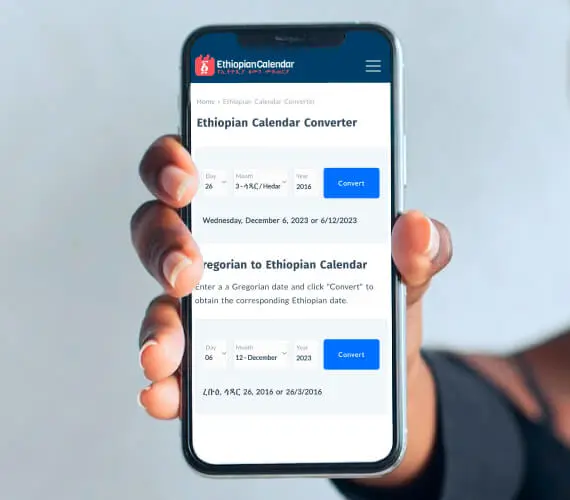Ethiopian Calendar Converter
Effortlessly convert Ethiopian calendar to Gregorian and vice versa with our user-friendly Ethiopian Calendar Converter. Simply enter any date, and click convert see its equivalent date in the other calendar.
EC to GC Converter (Ethiopian Calendar to Gregorian Calendar)
Enter an Ethiopian date and click the convert button to convert to Gregorian calendar date.

GC to EC Converter (Gregorian Calendar to Ethiopian Calendar)
Enter a a Gregorian date and click "Convert" to obtain the corresponding Ethiopian date.
Calendar Converter
Converting between the Ethiopian and Gregorian calendars can be a challenging task due to the fundamental differences in how each calendar system structures time. The Ethiopian Calendar, rooted in the ancient Coptic calendar, is about seven to eight years behind the Gregorian Calendar, which is the calendar most commonly used worldwide. Additionally, the Ethiopian year starts in Meskerem (around September 11 or 12 in the Gregorian calendar), and it has twelve 30-day months plus a unique thirteenth month, Pagumē, which contains five or six days depending on the leap year cycle.
Our calendar converter takes care of these complexities, allowing you to seamlessly convert any date between the Ethiopian and Gregorian systems. With just a simple date entry, this tool automatically accounts for the differences in year counts, month lengths, and leap year rules, delivering an accurate result every time. For example, a date that falls in early September on the Gregorian Calendar might already be in a new year in the Ethiopian Calendar, and our converter reflects this transition without any manual adjustments on your part.
Date Converter
This date converter is an essential tool for accurately converting significant dates between the Ethiopian and Gregorian calendars, ensuring that cultural, historical, and personal events are preserved with precision. Designed to be a user-friendly date converter online, it allows you to seamlessly align important moments such as birthdays, anniversaries, and historical dates. Whether you need an online date converter to record a loved one’s birthdate, plan cultural celebrations, or track milestones across both calendars, this tool offers a reliable and accurate solution. Particularly valuable for Ethiopian communities and families, it ensures that events are correctly documented and celebrated, regardless of the calendar system in use.
With our Ethiopian date converter, you can seamlessly track major milestones, ensuring that nothing meaningful gets lost in conversion. This date converter takes the guesswork out of date alignment, helping you celebrate and remember every occasion on the right day, no matter the calendar.
Birth Date Converter
An Ethiopian birth date converter offers a practical solution for accurately converting dates of birth between the Ethiopian and Gregorian calendars. Whether you’re planning a birthday celebration, recording a loved one’s Ethiopian birthday, or ensuring consistency in official documents, this tool makes the process simple and reliable. It’s especially valuable for families who want to honor traditions by recognizing Ethiopian birth dates while also accommodating international systems. Beyond its practicality, the birth date converter helps preserve cultural identity, making it easier to track and celebrate milestones across both calendars. Whether for personal or professional use, this tool ensures that important dates, including birthdays, are remembered and recorded accurately, bridging the gap between Ethiopian and Gregorian timelines.
The Gregorian vs Ethiopian calendar
The Gregorian calendar, the most widely used calendar globally, differs notably from the Ethiopian calendar in both structure and historical roots. While the Gregorian calendar, established in 1582, follows the solar year, the Ethiopian calendar aligns with a more ancient system, often showing a date that is 7–8 years behind the Gregorian year, depending on the month.
For those in business, the Gregorian calendar’s structure—with its 12 months and standardized 365 (or 366) calendar days—serves as a reliable annual calendar for planning and scheduling. As an online calendar or desktop calendar, it enables global businesses to synchronize schedules, track the lunar cycle, and even keep an eye on the current moon cycle, which remains crucial in fields where the phases of the moon impact operations.
In contrast, the Ethiopian calendar observes a 13-month year, consisting of 12 Ethiopian months of 30 days each and one short month, Pagumē, which has five or six days. This unique structure can be challenging for international operations, making the Gregorian system the dominant business calendar worldwide. Online calendar platforms help bridge these differences by offering conversion tools and compatibility with multiple calendar systems.
This alignment on a universal calendar simplifies business coordination and aids in time-sensitive planning, especially important in a globalized world. By integrating the solar-based Gregorian and the traditional lunar-based systems, modern calendar tools support users in tracking everything from daily tasks to the current moon cycle, with a single click on an online or desktop calendar.
Converting Ethiopian Date to Gregorian:
To convert an Ethiopian date (EY, EM, ED) to the Gregorian calendar, follow these steps. Firstly, add 7 or 8 years to the Ethiopian year (EY) to align with the Gregorian calendar, adjusting for the leap year cycle. Subtract 1 from the Ethiopian month (EM) to account for the Ethiopian month starting from 1. The Ethiopian day (ED) remains unchanged. If the Ethiopian year is a leap year, add 1 day to the converted Gregorian date. For example, if the Ethiopian date is 2015-04-25, the conversion results in the Gregorian date 2022-03-25.
Gregorian Date to Ethiopian Conversion:
Converting a Gregorian date (GY, GM, GD) to Ethiopian date involves several steps. Subtract 7 or 8 years from the Gregorian year (GY) to align with the Ethiopian calendar, considering the leap year cycle. Add 1 to the Gregorian month (GM) to adjust for the Ethiopian month starting from 1. The Gregorian day (GD) remains unchanged. If the Gregorian year is a leap year, subtract 1 day from the converted Ethiopian date. For instance, if the Gregorian date is 2022-03-25, the conversion yields the Ethiopian date 2014-04-25.
